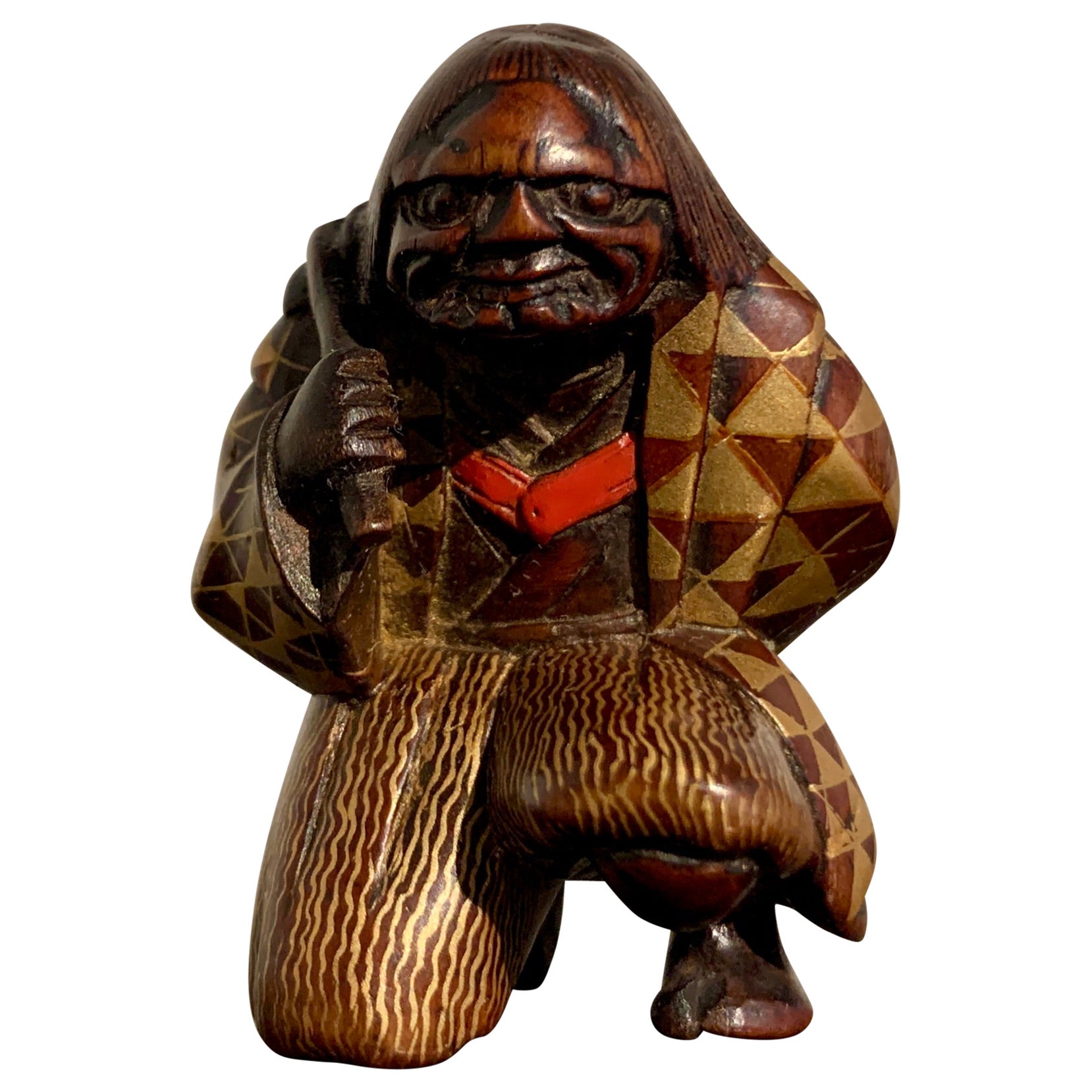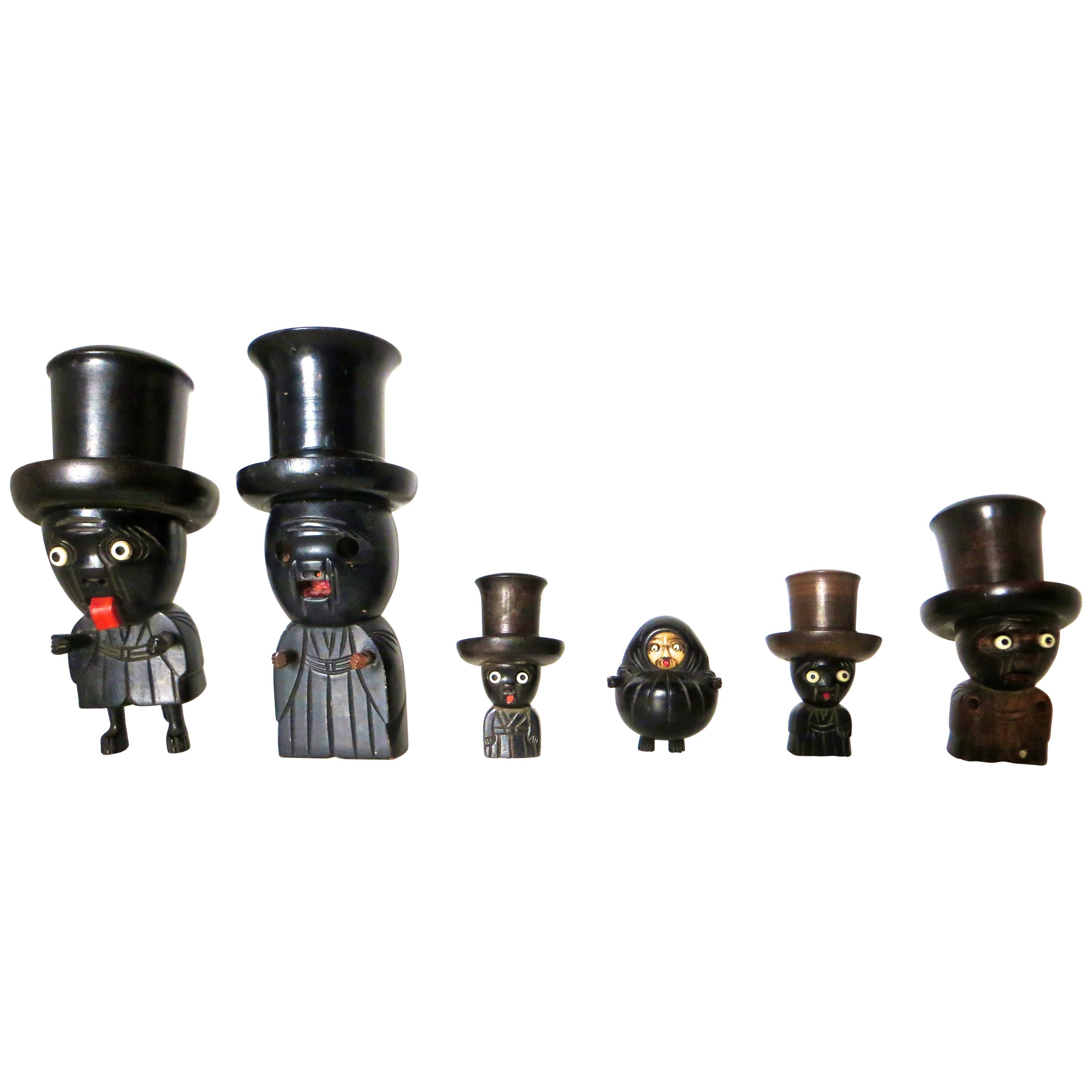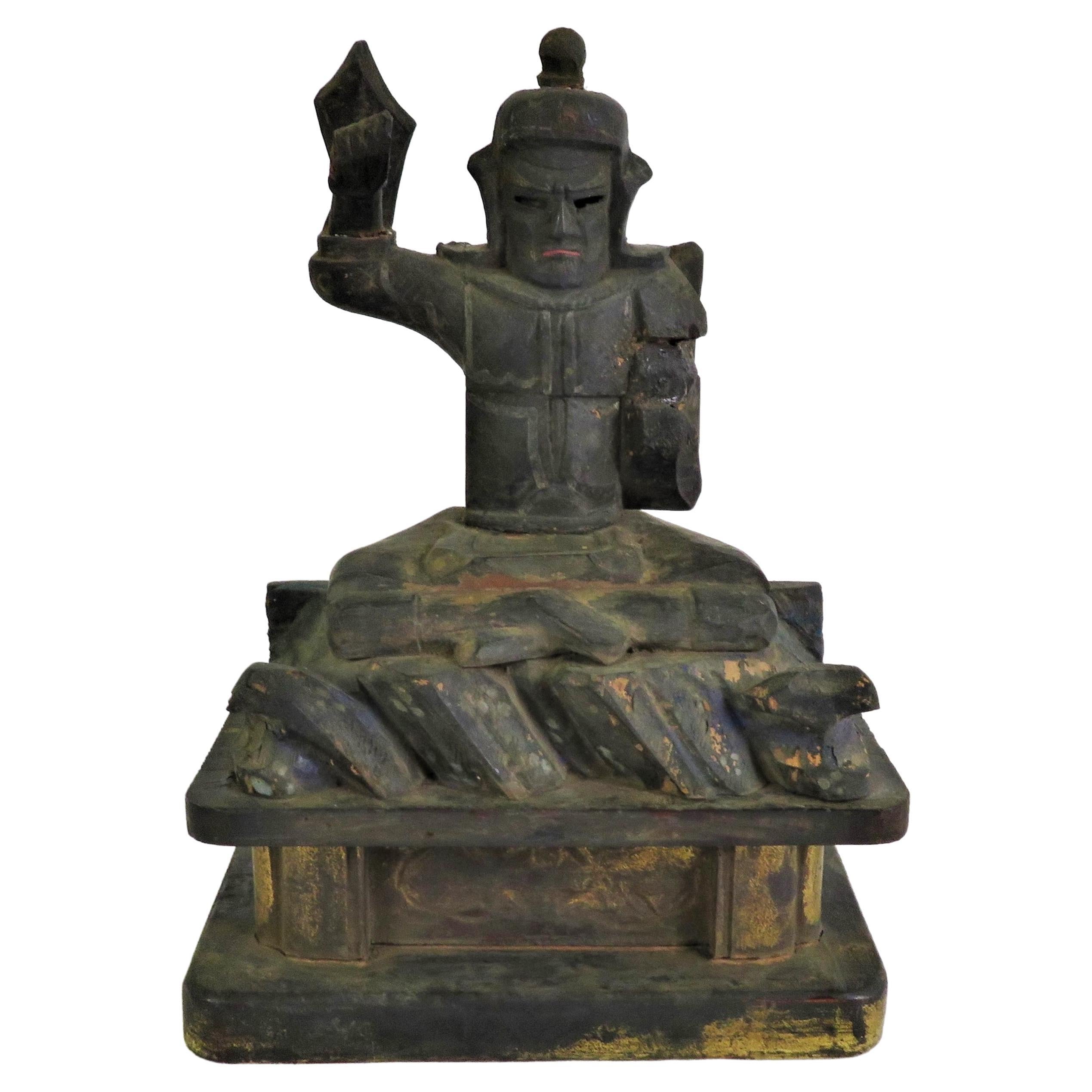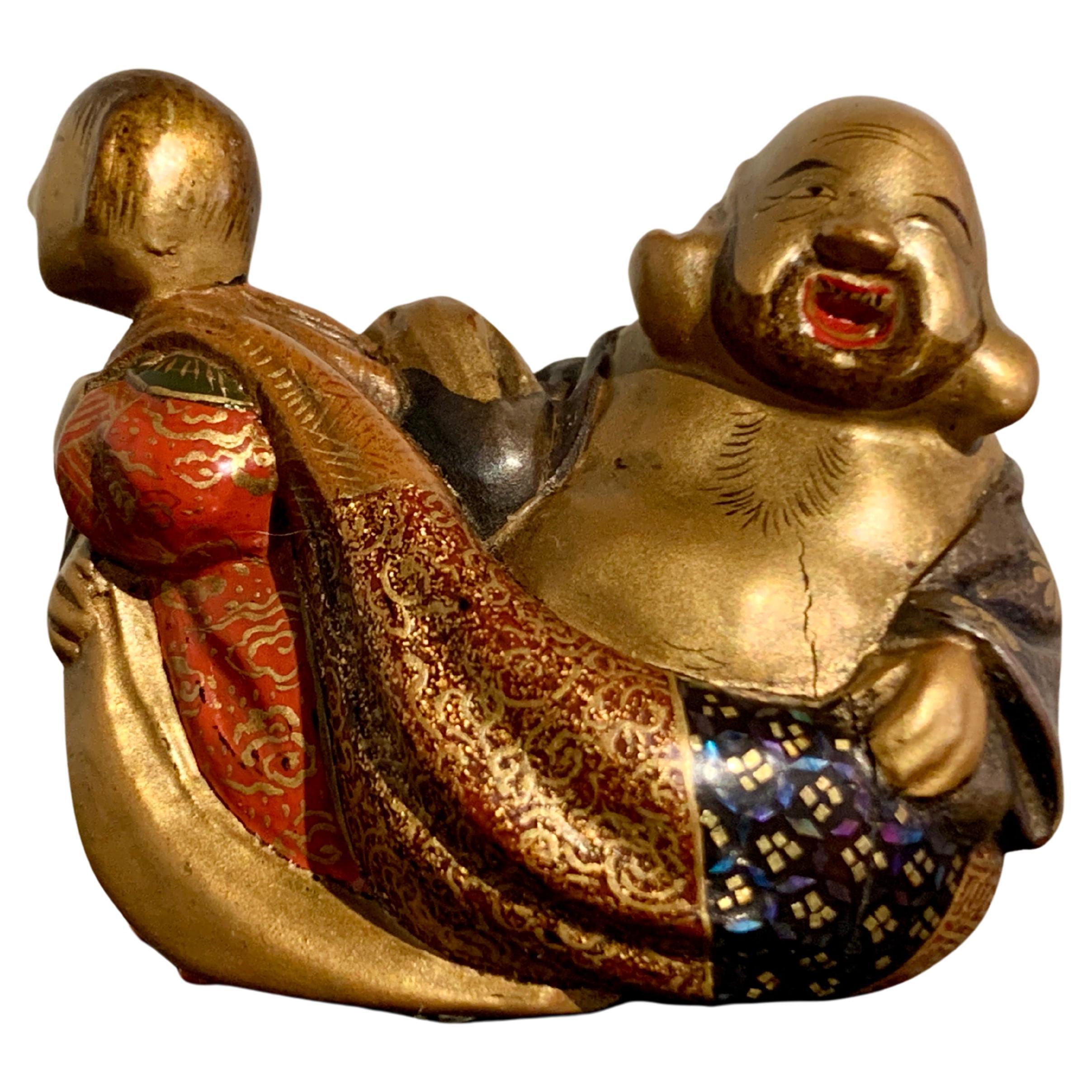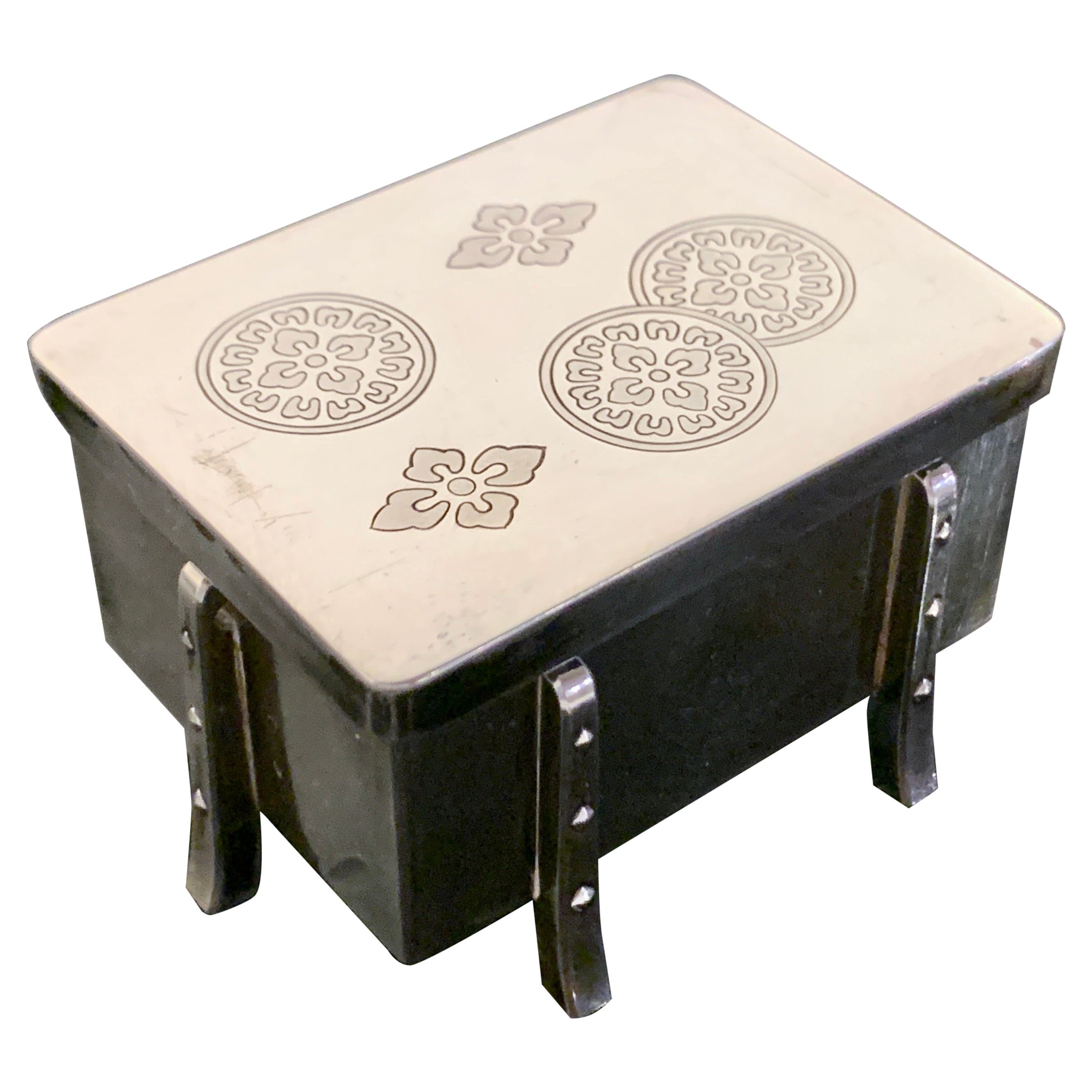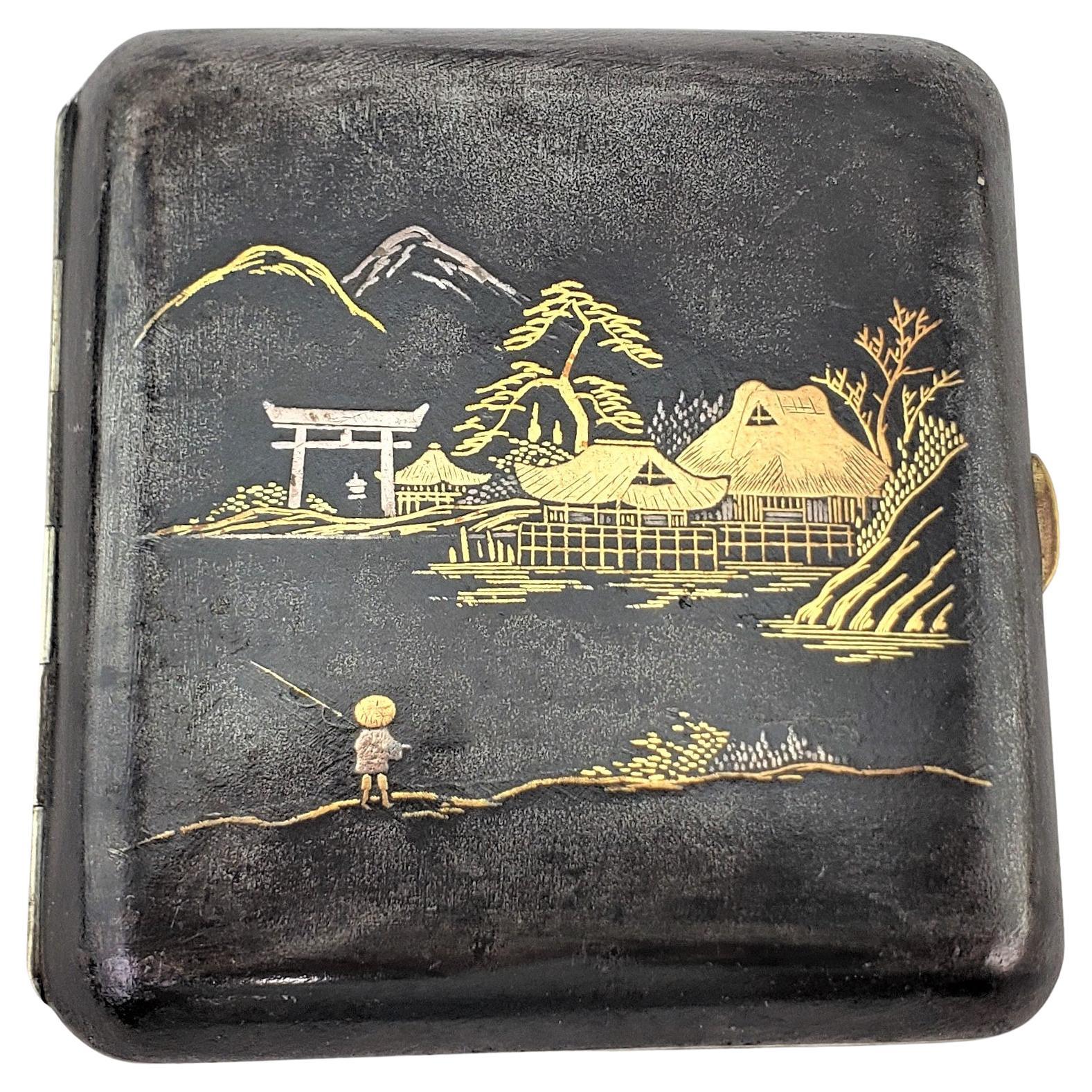Items Similar to Japanese Meiji Period Komai Inlaid-Iron Pagoda Model
Video Loading
Want more images or videos?
Request additional images or videos from the seller
1 of 11
Japanese Meiji Period Komai Inlaid-Iron Pagoda Model
About the Item
Japanese Meiji period Komai inlaid-iron pagoda model
Japanese, Late 19th Century
Temple: Height 33cm, width 15cm, depth 15cm
Base: Height 2 cm, width 13.5cm, depth 13.5cm
Together: Height 35cm, width 15cm, depth 15cm
This outstanding and extremely detailed Komai pagoda model was superbly crafted by skilled Japanese artists in the late 19th century. The Nunome Zogan technique (also known as Komai) has been expertly used, whereby gold is inlaid into iron to create detailed and attention-grabbing designs. Its two-tiered shape is adorned with a plethora of intriguing illustrations encouraging one to spend time to notice all of them.
The pagoda is topped by a slender finial made up of sacred rings as well as other symbolic features. From it, extend several delicate chains all terminating on the roof. Scenes of dragons which in Japanese culture are considered as the protectors of mankind fill all panels of the roofs. Charming bells hang under the four corners of each roof.
The two levels are modelled as verandas with railings. All sides of the pagoda are wonderfully adorned with nature-inspired scenes as well as motifs relating to Japanese culture. Both tiers include lockable compartments that open to reveal pairs of drawers, their fronts decorated with further illustrations. Two larger drawers are hidden in the square base which supports the whole pagoda construction.
The pagoda stands on a refined wooden plinth, the geometric shape complementing the carefully thought-out design of the gold-inlaid iron model.
Showcasing superb Japanese craftsmanship, this Meiji period sculpture would make an outstanding addition to one’s collection.
- Dimensions:Height: 13.78 in (35 cm)Width: 5.91 in (15 cm)Depth: 5.91 in (15 cm)
- Style:Meiji (Of the Period)
- Materials and Techniques:
- Place of Origin:
- Period:
- Date of Manufacture:Late 19th Century
- Condition:Wear consistent with age and use.
- Seller Location:London, GB
- Reference Number:
About the Seller
5.0
Recognized Seller
These prestigious sellers are industry leaders and represent the highest echelon for item quality and design.
Gold Seller
These expertly vetted sellers are highly rated and consistently exceed customer expectations.
Established in 1975
1stDibs seller since 2012
361 sales on 1stDibs
Typical response time: 5 hours
Associations
The British Antique Dealers' AssociationInternational Confederation of Art and Antique Dealers' Associations
- ShippingRetrieving quote...Ships From: London, United Kingdom
- Return PolicyA return for this item may be initiated within 14 days of delivery.
More From This SellerView All
- Very Large Japanese Meiji Period Cloisonne Enamel VaseLocated in London, GBThis stunning Meiji period vase is a wonderful example of the quality of craftsmanship during the late 19th century Japanese Meiji period. The Meiji era was famed for being the perio...Category
Antique Late 19th Century Japanese Meiji Vases
MaterialsEnamel
- Pair of Antique Meiji Period Japanese Cloisonne Enamel VasesLocated in London, GBThese beautiful Japanese vases were crafted during the Meiji period of the late 19th Century, which was referred to as the Golden Age of cloisonne enameling. The vases are of elo...Category
Antique Late 19th Century Japanese Meiji Vases
MaterialsEnamel
- Group of Fourteen Japanese Meiji Period Gilt Metal PlaquesLocated in London, GBGroup of fourteen Japanese Meiji period gilt metal plaques Japanese, Late 19th Century Height 2cm, width 2cm These beautiful Japanese Meiji period plaque...Category
Antique Late 19th Century Japanese Meiji Metalwork
MaterialsMetal
- 19th Century Cloisonné Enamel Dragon Vase, Meiji Period JapanLocated in London, GBThis intricately decorated antique Japanese vase was crafted in the Meiji period (1868-1912). The vase is of circular form and features a waisted base, large, ovoid body and a lid wi...Category
Antique Late 19th Century Japanese Meiji Vases
MaterialsEnamel
- Large Meiji Period Cloisonne Enamel KoroLocated in London, GBLarge Meiji Period Cloisonne Enamel Koro Japanese, late 19th Century Height 88cm, width 76cm, depth 53cm This superb cloisonne enamel koro was made during Japan's Meiji period, and ...Category
Antique Late 19th Century Japanese Meiji Metalwork
MaterialsBronze, Enamel
- Large Meiji Period Cloisonne Enamel VaseLocated in London, GBOf ovoid form, with a narrow neck and outward flaring rim, on dark blue ground depicting wisteria blossoms in white and purple cascading from the shoulder with birds throughout and w...Category
Antique Late 19th Century Japanese Meiji Vases
MaterialsEnamel
You May Also Like
- Carved Boxwood and Lacquer Netsuke of a Noh Dancer, Meiji Period, JapanLocated in Austin, TXA fine lacquer decorated carved boxwood netsuke of a Noh dancer in a Hannya role, unsigned, Meiji period, late 19th century, Japan. The boxwood netsuke finely carved as a kneeling Noh dancer dressed in striking geometric patterned robes. The actor holds an opened war fan behind their back in one hand, a Shinto wand slung over the shoulder in the other. The war fan, tessen, decorated in red lacquer with a golden rising sun at the center. Tessen were sturdy fans used by samurai as protective devices, and sometimes as weapons. The wand, called an onusa, is a traditional Shinto ritual implement comprised of folded paper streamers, shide, attached to a wooden wand, often used in purification rituals. Here, the shide are crafted from silver maki-e, with the handle of the natural boxwood. The actor wears a fierce and unearthly hannya mask...Category
Antique 1890s Japanese Meiji Sculptures and Carvings
MaterialsBoxwood, Lacquer
- Six Kobe Toys, Japanese, Meiji Period, circa 1900By Kobe ToysLocated in Incline Village, NVKobe Toys are very mysterious and not much is known about them. They were created and hand made during the Meiji period in Japan, which covered the years 1868...Category
Antique Early 1900s Japanese Folk Art Toys
MaterialsEbony
- Late Meiji Period Folk Wood Carving Japanese God of War, Arts, Shrines ProtectorLocated in Miami, FLProbably more than likely from a Japanese home altar, this is a folk art rendition of Hachiman Yahata no Kani, Japanese God of War, Archery, Culture and Pro...Category
Antique Early 1900s Japanese Meiji Figurative Sculptures
MaterialsWood
- Boxwood and Lacquer Netsuke of Hotei by Shunsho, Meiji period, circa 1900, JapanLocated in Austin, TXA charming and finely decorated carved and lacquered boxwood netsuke of Hotei by Shunsho (probably Shunsho XI, Masaoki), Meiji period, circa 1900, Japan. This delightful and colorful netsuke features the beloved figure Hotei, one of the Seven Lucky Gods. The god of fortune and happiness is seated upon his treasure bag, and being dragged by a smiling child. Carved from boxwood and decorated in bright lacquers of gold, silver, red, black and green. Hotei's chest and ample stomach mostly exposed, his skin covered in gold lacquer. Large elephantine ears frame his bearded face. His red-lipped mouth open in an uproarious laugh. Hotei's treasure bag formed as a patchwork of various brocades in gold, red, and black lacquer. The black lacquer further decorated in the lac burgaute...Category
Antique Early 1900s Japanese Meiji Sculptures and Carvings
MaterialsBoxwood, Lacquer
- Japanese Silver Karabitsu Bonbonniere Box, Taisho Period, JapanLocated in Austin, TXA fine Japanese silver bonbonniere box in the shape of a karabitsu, Meiji Period, circa 1900, Japan. The small bonbonniere crafted of silver in the form of a karabitsu, a storage ...Category
Vintage 1920s Japanese Meiji Metalwork
MaterialsSilver, Sterling Silver
- Antique Japanese Damascene Komai Styled Yellow Gold Decorated Cigarette CaseLocated in Hamilton, OntarioThis antique Japanese cigarette case is signed by an unknown artist, and dates to approximately 1920 and done in an Anglo-Japanese style. This ...Category
Early 20th Century Japanese Anglo-Japanese Tobacco Accessories
MaterialsMetal
